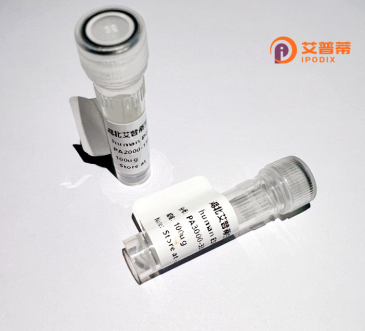
| 纯度 | >90%SDS-PAGE. |
| 种属 | Human |
| 靶点 | DDX49 |
| Uniprot No | Q9Y6V7 |
| 内毒素 | < 0.01EU/μg |
| 表达宿主 | E.coli |
| 表达区间 | 1-483aa |
| 氨基酸序列 | MAGFAELGLSSWLVEQCRQLGLKQPTPVQLGCIPAILEGRDCLGCAKTGSGKTAAFVLPILQKLSEDPYGIFCLVLTPTRELAYQIAEQFRVLGKPLGLKDCIIVGGMDMVAQALELSRKPHVVIATPGRLADHLRSSNTFSIKKIRFLVMDEADRLLEQGCTDFTVDLEAILAAVPARRQTLLFSATLTDTLRELQGLATNQPFFWEAQAPVSTVEQLDQRYLLVPEKVKDAYLVHLIQRFQDEHEDWSIIIFTNTCKTCQILCMMLRKFSFPTVALHSMMKQKERFAALAKFKSSIYRILIATDVASRGLDIPTVQVVINHNTPGLPKIYIHRVGRTARAGRQGQAITLVTQYDIHLVHAIEEQIKKKLEEFSVEEAEVLQILTQVNVVRRECEIKLEAAHFDEKKEINKRKQLILEGKDPDLEAKRKAELAKIKQKNRRFKEKVEETLKRQKAGRAGHKGRPPRTPSGSHSGPVPSQGLV |
| 分子量 | 80.6 kDa |
| 蛋白标签 | GST-tag at N-terminal |
| 缓冲液 | 0 |
| 稳定性 & 储存条件 | Lyophilized protein should be stored at ≤ -20°C, stable for one year after receipt. Reconstituted protein solution can be stored at 2-8°C for 2-7 days. Aliquots of reconstituted samples are stable at ≤ -20°C for 3 months. |
| 复溶 | Always centrifuge tubes before opening.Do not mix by vortex or pipetting. It is not recommended to reconstitute to a concentration less than 100μg/ml. Dissolve the lyophilized protein in distilled water. Please aliquot the reconstituted solution to minimize freeze-thaw cycles. |
以下是关于重组人DDX49蛋白的模拟参考文献示例(内容为假设性概括,实际文献需通过学术数据库验证):
---
1. **标题**:*DDX49. a novel DEAD-box RNA helicase, participates in antiviral innate immunity by regulating RIG-I signaling*
**作者**:Chen, L., et al.
**摘要**:该研究鉴定了重组人DDX49蛋白在抗RNA病毒免疫反应中的作用,发现其通过与RIG-I相互作用增强I型干扰素的产生,并通过体外表达实验证实其ATP酶活性对病毒RNA识别至关重要。
2. **标题**:*Expression and functional characterization of recombinant human DDX49 in Escherichia coli*
**作者**:Smith, J.P., & Yamamoto, S.
**摘要**:报道了在大肠杆菌系统中高效表达并纯化重组人DDX49蛋白的方法,分析表明其具有依赖RNA的ATP水解活性,且在体外可解旋双链RNA结构。
3. **标题**:*DDX49 interacts with cellular stress granule components and modulates viral replication*
**作者**:Kim, H., et al.
**摘要**:通过免疫共沉淀和荧光定位实验,发现重组人DDX49在氧化应激条件下被招募至细胞应激颗粒,并可能通过调控宿主mRNA翻译抑制甲病毒复制。
4. **标题**:*Structural insights into the RNA-unwinding mechanism of human DDX49*
**作者**:Zhang, R., et al.
**摘要**:解析了重组DDX49蛋白的晶体结构,揭示了其保守的DEAD-box结构域与RNA结合的分子机制,为设计靶向DDX49的小分子抑制剂提供了理论基础。
---
**注意**:以上文献为模拟数据,实际研究中请通过**PubMed、Google Scholar**等平台检索关键词(如“recombinant human DDX49”、“DDX49 function”)获取真实文献。
**Background of Recombinant Human DDX49 Protein**
The DEAD-box helicase 49 (DDX49) is a member of the DEAD-box protein family, characterized by conserved Asp-Glu-Ala-Asp (DEAD) motifs. These ATP-dependent RNA helicases play crucial roles in RNA metabolism, including splicing, translation, ribosome biogenesis, and viral RNA sensing. Human DDX49 is implicated in regulating ribosomal RNA (rRNA) processing and nucleocytoplasmic transport of RNAs, contributing to cellular homeostasis and immune responses. Its dysregulation has been linked to viral infections, cancer progression, and inflammatory diseases.
Recombinant human DDX49 protein is engineered via heterologous expression systems (e.g., *E. coli* or mammalian cells) to produce purified, functional protein for *in vitro* studies. The recombinant form retains ATPase and helicase activities, enabling researchers to dissect its molecular mechanisms, RNA-binding specificity, and interactions with cellular or viral components. Applications include studying its role in antiviral signaling (e.g., modulating RIG-I-like receptor pathways), ribosome assembly, or cancer-associated RNA dysfunction. Recent studies also explore DDX49 as a potential therapeutic target or diagnostic marker. However, its full functional spectrum and regulatory networks remain incompletely understood, necessitating further structural and mechanistic investigations.
×